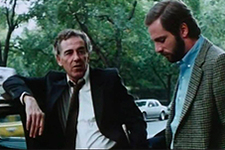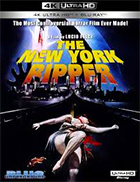The New York Ripper (Lo squartatore di New York) (4K UHD)
|  To say that The New York Ripper (Lo squartatore di New York) is Italian splatter-master Lucio Fulci’s most notorious film is a statement of some magnitude, given how notorious so many of his films were—and still are. To his fans, Fulci is an underappreciated genius whose no-holds-barred approach to sex and violence marked the apotheosis of Italian horror in the 1970s and ’80s, an era of one-upmanship among horror filmmakers that resulted in many such films being banned in various countries (The New York Ripper was banned in the U.K. for years, as the BBFC refused to even consider it for licensure, and it was barely released in edited form in the U.S. two years later). To his critics, Fulci is a misogynistic hack who relies far too much on cheap sensationalism, incoherent plotting, and lurid violence that pushes far beyond any sense of artistry or even purpose beyond rubbing the audience’s nose in the gore. While many of Fulci’s films have isolated moments of Hitchcockian suspense and memorable atmosphere, far too often his faults—and his excesses—drag his films down, making them all but unwatchable to all but the most passionate (or perverse) horror aficionados. Such is the case with The New York Ripper, which clearly earned its notoriety and has maintained it in the decades since its release. If anything, the film feels even grittier, sleazier, and more nihilistic than it did when it premiered in 1982, the year after Fulci’s The Black Cat, The Beyond, and House by the Cemetery (say what you will about him, but he was productive). The film marked Fulci’s return to the giallo—the uniquely Italian take on the murder-mystery genre—after making primarily supernatural horror films for the previous five years, and even though it was shot by Luigi Kuveiller, who had previously shot Billy Wilder’s Avanti! (1972), Paul Morrissey’s Flesh for Frankenstein (1973) and Blood for Dracula (1974), and Dario Argento’s Deep Red (1975), there is nothing visually distinguished about the film, save a few isolated setpieces and some dramatically lit shots. Instead, Fulci digs as deep as he can into the visual cesspool of early ’80s New York when the Big Apple’s downtown was its most rotten, seething with sex clubs, porn theaters, graffiti-covered subways, and fleabag motels. It is the same milieu that Martin Scorsese mined for such unnerving dramatic effect in Taxi Driver (1976), which spawned dozen of imitators, including films in the horror genre such as Abel Ferrara’s Driller Killer (1979) and William Lustig’s Maniac (1980). Scorsese made the moral rot embodied in Times Square’s neon, trash-strewn garishness central to his film’s significance, whereas Fulci appears to be doing little more than exploiting it for background atmosphere. As it turns out, the decay of the city has nothing to do with the film’s serial killer, who slices up attractive young women with razor blades, switchblades, and, in one particularly gruesome scene, a broken bottle. Fulci lavishes his trademark close-ups on all the skin splitting and blood gushing, often to the point of near absurdity, as it requires the victims to simply stand there and scream while being cut up, rather than struggling and trying to run. The screenplay was originally written by Gianfranco Clerici (Cannibal Holocaust), Vincenzo Mannino (House on the Edge of the Park), and Fulci, although Dardano Sacchetti, who had had a hand in several of Luci’s most recent films, including City of the Living Dead (1980), The Beyond (1981), and The House by the Cemetery (1981), was brought in late to do substantial rewrites. The ostensible protagonist is Lieutenant Fred Williams (Jack Hedley), a world-weary, on-the-edge-of-retirement police detective who is tracking the killer, although with little intensity or drive. He is surrounded by an odd cast of supporting characters, including Fay Majors (Almanta Suska), a young woman who is a rare survivor of one of the Ripper’s attacks; Jane Lodge (Alexandra Delli Colli), a wealthy hedonist who enjoys degrading herself at sex clubs and scummy bars; and Dr. Paul Davis (Paolo Malco), an arrogant young psychoanalyst who is brought on board early in the film and basically hangs around so that he can supply some kind of psychological explanation for all the violence at the end. And then there’s Mickey Scellenda (Howard Ross), the primary suspect who is simply too obvious a culprit to actually be the Ripper. But that doesn’t stop Fulci from squeezing every bit of misdirection he can out of the character, although this does result in the film’s one genuine stand-out suspense sequence, when a character learns via a late-night radio broadcast that she may very well be tied up in bed with the killer and has to figure out how to untie herself and escape without waking him. The New York Ripper has been frequently described as misogynistic for the way it lavishes such time and energy on the physical maiming of screaming young women, which is not exactly unique to Fulci’s film. Women have almost always been the victims of violence in the horror genre, and directors as gifted as Alfred Hitchcock, Dario Argento, and Brian De Palma have unapologetically exploited this tendency, often to critical acclaim. The problem with Fulci is that he foregrounds the violence against women so emphatically and makes the rest of the film so empty that the gendered bloodshed literally becomes the film itself (it doesn’t help that the violence is so interconnected with graphic sexuality and one of the film’s main female characters can only express herself via willful sexual degradation). It leaves you with a sour taste, especially since Fulci and his screenwriters fail to provide us with any redeeming or even mildly interesting characters. I have to say, though, that one aspect of the film that has often been mocked I found to be deliriously and unexpectedly effective: the killer’s use of a high-pitched quacking voice when he (or she) calls and taunts the victims or Lt. Williams. The concept sounds positively ludicrous, I know, but somehow it works on-screen in a weird, unnerving, genuinely subversive kind of way, which makes one wish that Fulci had focused more on making The New York Ripper intriguing, rather than just sleazy.
Copyright © 2020 James Kendrick Thoughts? E-mail James Kendrick All images copyright © Blue Underground | |||||||||||||||||||||||||||||
Overall Rating: 
 (1.5)
(1.5)


